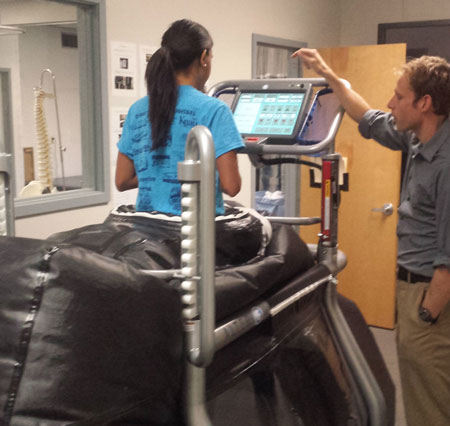
Gingerly stepping into the opening of a deflated rubber tent mounted on a large treadmill while wearing ungainly neoprene shorts does not inspire thoughts of speed or efficiency, let alone balance.
Deploying a heavy zipper and locking in latches adds only a little confidence that the clunky endeavor will end well. But when the AlterG anti-gravity treadmill inflates into action and you start walking, then running, at 80 percent of your bodyweight or less supported by a cushion of air, the transformation into lightness seems almost magical.
If only pounding the pavement could feel so easy.
That’s part of the point, said Dirk de Heer, assistant professor of physical therapy at Northern Arizona University, but it’s not the only lesson to be learned from this unusual and uncommon piece of equipment.
“When I first started looking into this machine, I said, ‘Hey, this is not a tool that is just for elite athletes,” de Heer said, although four years ago they were the ones pioneering its use. “The things they were trying to achieve also make it easier for people to walk with lower impact.”
Using funding from a Technology Research Initiative Fund grant in October 2012, de Heer added an AlterG to the physical therapy lab at NAU’s Flagstaff campus with the aim of conducting research on the effectiveness of the AlterG for “all kinds of people with injuries and difficulty walking.”
The range of users extends from stroke patients to those with Parkinson’s or multiple sclerosis—and in Flagstaff, of course, includes NAU athletes and some of the top runners in the world.
“We’ve had the whole spectrum of performance on the machine,” de Heer said.
For someone with a debilitating illness or injury, just the feeling of being able to take a few steps can be physically therapeutic and a crucial confidence builder. Supported at the waist by a bag of pressurized air, users may choose from a digital readout of pace and percentage of bodyweight to make the painful or impossible seemingly evaporate beneath their feet.
“Body weight-supported training is not something new but the way the AlterG achieves it is different from traditional methods,” de Heer said. Patients are experiencing the machine’s potential at two student-run neuro-clinics held annually at NAU under the supervision of full-time faculty, he said.
While such patients may see immediate results, top athletes are more interested in the AlterG’s potential for recovery from, and prevention of, injury as part of a high-mileage routine. At NAU, the research is ongoing. Runners who use the machine consent to their performance and recovery data being recorded so hard science can be added to growing anecdotal evidence.
“Little is known about clinical research on the AlterG, so I think a barrier is that we’re still finding out what the effectiveness of the machine is,” de Heer said. Physical therapy graduate student John Kline, like de Heer a former collegiate runner, has focused his capstone project on learning more about the AlterG’s potential.
As de Heer explained, “If you take 10 percent off somebody’s body weight, they’re going to run faster and it’s going to be easier. But how much faster do they need to run to have the same effort?”
The answer, Kline’s research is beginning to show, is that a runner must go quite a bit faster, to the point that achieving the same intensity as a typical training run can be challenging. But there’s still a benefit.
“In turn, you get a much lower impact on your legs,” de Heer said. “So if you had an injury, you could still get a good workout, and if you go to 70-80 percent of your bodyweight, you could do the exact same workout as you normally do but have less stress on your body.”
In February, Kline presented his initial research results at the Combined Sections Meeting of physical therapists in Las Vegas, and he will also present in May at the American College of Sports Medicine and World Congress on Exercise in Medicine, to be held in Orlando.



